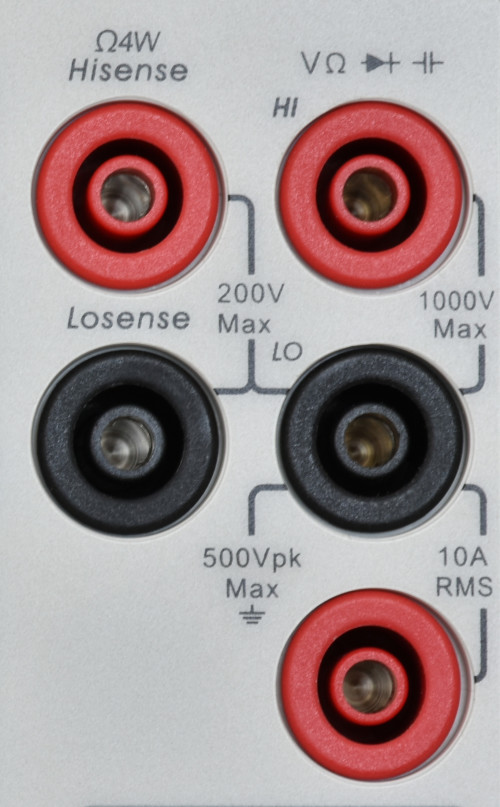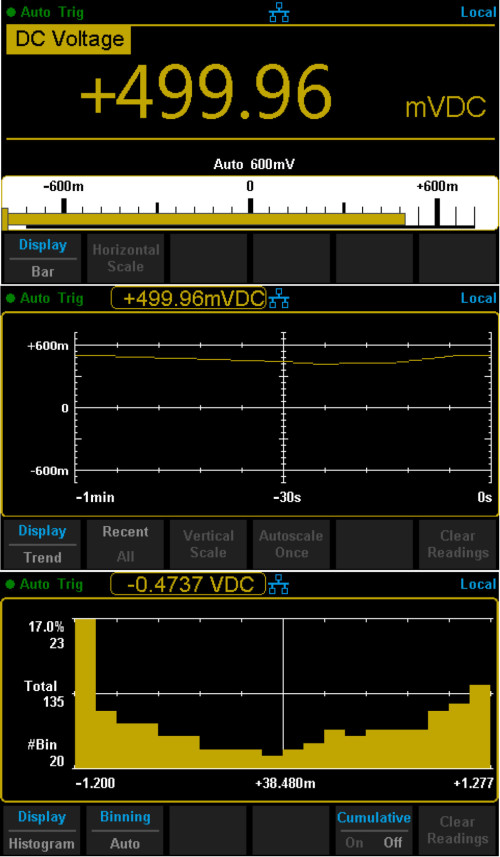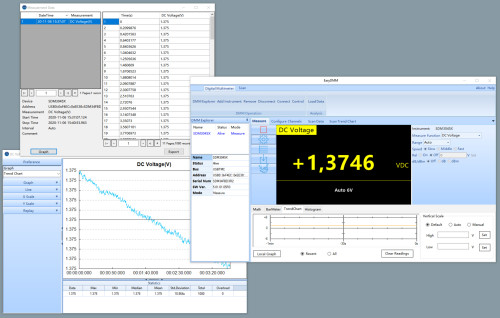Review: Siglent Bench Multimeter SDM3045X
on
Every electronics enthusiast will have one or more multimeters. But have you ever considered purchasing a bench multimeter instead of a hand-held one? These usually offer many more features and a better display. The Siglent SDM3045X is a 4½-digit bench multimeter with a basic accuracy of 0.02% and many interface options. Here follows our impression after having tested it for a few months.
Anyone who does anything with electronics will have one or more multimeters. You can already have one for some 10 euros, but for increased robustness, greater safety, more features and better accuracy that amount will quickly increase to a few hundred euros. The accuracy, in particular, is something that has a great influence on the price.
At home I’ve always worked with a simple multimeter. Last year, after decades of faithful service, it was finally replaced with a better version that has a dual display and, especially, a better accuracy than the old one. I have been very pleased with it. When I had the opportunity to test a bench version of a multimeter from Siglent, I though it would be a good idea to compare it to my hand-held multimeter. This Siglent is more expensive to buy, but perhaps it is worth the additional expense. Which meter is easier to use and what are the advantages and disadvantages of each type?
The equipment
This is the ‘smallest’ bench multimeter from Siglent, out of a series of three, but apart from a fewer number of digits and a lower basic accuracy, this SDM3045X still offers the same feature set that the more expensive versions also offer. If this amount of accuracy is sufficient for you, then this model will give you the best price/performance ratio.
The SDM3045X is provided with a sturdy metal enclosure that has plastic protection bumpers on the corners. The carrying handle can be rotated into various positions, so that the front of the meter can be tilted up at an angle. The enclosure has the same dimensions as many of the other devices from Siglent (such as the signal generators), so that the equipment can be stacked together easily.
On the front is a clear 4.3” colour display. Below that are six soft-menu buttons, the functions of which appear on the display. On the right are the usual meter function buttons (most of which have a secondary function) plus a set of cursor keys for navigating through the menus and the setting of values.
There are five input sockets (Figure 1), two for the normal inputs, two sense inputs for four-wire resistance measurements and a current measuring input.

On the back we find an IEC mains input socket, a USB connector and a LAN connector for connecting to a computer or network, and two BNC sockets for external triggering. There is also a fuse holder for the current measurement function.
Measurement features
The SDM3045X has, of course, all those functions that you would also find on a good hand-held multimeter: voltage and current ranges, resistance, capacitance, frequency, dB(m), temperature and diode/continuity measurements, auto-ranging and – as is now common with the better multimeters – the option to display two measurement values simultaneously (for example, AC voltage and frequency). The meter has a display that shows a maximum of 66000 counts and has a basic accuracy of 0.02% (DC voltage). It can make up to 150 measurements/s. The instrument has not been designed for use with high-voltage circuits (CAT I (10000 V)/CAT II (300 V)), but then you wouldn’t use such a bench meter in an electronics lab for that anyway. The meter can be operated from a PC via LAN or USB, or the measurement results can be stored.
With the voltage measurements you can choose from different display options, such as an additional bar display below the value, a trend graph or a histogram (Figure 2).

There are also various mathematical functions. Many meter functions have various options available. It is too much to mention everything that this meter is capable of here, but to give a few examples, in the 600-mV range you can choose between an input impedance of 10 MΩ or 10 GΩ, with the diode test function you can set the test voltage between 0 and 4 V, and with the temperature measurement you can select from different configuration options, depending on the type of temperature sensor that is used. It is possible to trigger the meter manually or externally, so that it performs a certain number of measurements. Furthermore, high and low thresholds can be specified to test whether a value is within that range. The internal flash memory of 1 GB can store up to 10,000 measurement results.
Configuration settings and measurement results can be stored on a USB stick, using the USB connector on the front. If you would like to connect the meter to a PC then you have the option of either a USB or LAN connection (Figure 3).

The accompanying software, EasyDMM, (Figure 4) is only suitable for Windows, but that will not be a problem for the majority of electronics enthusiasts.

Both the operation of the meter and the storing of measurement sequences is possible with this software. As with most of the other Siglent test equipment, this meter also uses standard SCPI commands, handy for those who would like to put their own test procedures together.
Multimeter in practice
The biggest difference between this bench multimeter and a hand-held multimeter is perhaps the fact that the first is powered from the mains. This may look like a disadvantage, but if you always use the meter at the same location then you will hardly notice that. You give the SDM3045X a position on your lab bench, connect it up and then it normally just stays there next to the ‘scope, the power supply and the other test equipment. I once kept track of how often I actually carried my hand-held multimeter to another location; this turns out to be only on the very rare occasion. Most of the time I work at my lab bench and that is also where I use the multimeter. Since the SDM3045X has been on my lab bench (Figure 5), I have barely made use of my hand-held multimeter (I used both when I wanted to make two measurements simultaneously).

The 3045X is much more stable on the bench than a hand-held DMM and with its fold-out support I found the operation of the pushbuttons a lot more convenient than a rotary switch.
It does take a little bit of time to get used to its operation and all the functionality, mainly because there are so many configuration options. And when you switch it on you need to have a little patience until the ‘computer’ has started up, this is clearly different compared to a hand-held multimeter. But otherwise there are only advantages: a big and clear display and just about all the features you could imagine for a multimeter. The accuracy is fantastic and with AC voltage measurements, the large frequency range to 100 kHz is also a bonus; most hand-held multimeters don’t even make it up to the audio range.
If you require greater accuracy then you can turn to its more expensive sibling, the SDM3055, which offers an additional digit. However, one big advantage of the SDM3045X is that it does not have a fan, in contrast to the 3055, and is therefore as quiet as a mouse. The accompanying PC software is well-organised and ideal for the logging of measurement results. You will have observed already: I have barely taken my hand-held multimeter from its storage case, this instrument offers so much more!
Check out the SDM3045X
If you are prepared to spend a little more on a good multimeter, then I can certainly recommend you to take a look at the SDM3045X and all the features that are described in the datasheet. This bench multimeter will make an excellent companion, both on the professional as well as the hobby work bench, that is capable of so much more than a hand-held multimeter, and in my experience is also easier to operate and read.


Discussion (0 comments)